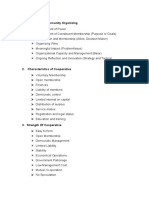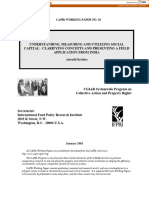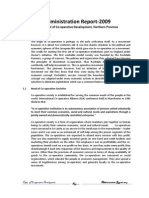Chapter1-3 Thesis
Chapter1-3 Thesis
Uploaded by
AnaSolitoCopyright:
Available Formats
Chapter1-3 Thesis
Chapter1-3 Thesis
Uploaded by
AnaSolitoOriginal Description:
Copyright
Available Formats
Share this document
Did you find this document useful?
Is this content inappropriate?
Copyright:
Available Formats
Chapter1-3 Thesis
Chapter1-3 Thesis
Uploaded by
AnaSolitoCopyright:
Available Formats
EFFECTIVENESS OF COOPERATIVE FOR
COMMUNITY DEVELOPMENT
IN CAUAYAN CITY, ISABELA
In partial fulfillment of the Requirements
In Methods of Research
By:
Analyn B. Solito
Masters in Business Administration
CHAPTER I
PROBLEM AND BACKGROUND OF THE STUDY
This chapter presents the background of the study, problem and its significance,
and the scope and delimitation of the study.
INTRODUCTION
The evolution of community development theory has not yet generated a parallel
advance in implementation strategies. The traditional paradigm, with its focus on helping
communities regain their past glory, was associated with business attraction, retention, and
expansion strategies (Shaffer, Deller, and Marcouiller 2004). Practical approaches to
implementing contemporary paradigms are less clear. Part of the issue is that self-help,
asset-based, and self-development theories focus as much on process (building community
efficacy) as on outcomes. In addition, the outcomes are no longer concrete effects such as
jobs and income, but rather nebulous concepts like innovation and entrepreneurial activities.
The more important dynamic, however, is the underlying tenet of contemporary theory that
communities need to find their own strategies; identifying generic, one-size fits all strategies
seems antithetical to the individualistic, self-help models. We expound a strategy
cooperative developmentthat compliments contemporary community development
paradigms and thus, provide communities and practitioners with an effective (and perhaps
unfamiliar) vehicle for development.
Cooperatives are viewed as important vehicles for community development because
they mobilize local resources into a critical mass and their structure allows them to be more
community-oriented (Fairbairn et al. 1991; Wilkinson and Quarter 1996). Cooperative
businesses can be found in nearly all countries, existing in numerous and varied sectors of
the economy.
This paper fills an important gap in both theory and practice. Although cooperative
leaders, cooperative developers, and cooperative scholars consider cooperatives an
important vehicle for community development, most have stopped short of prescribing how
cooperatives can be incorporated into community development paradigms.
Their perspective, that cooperatives are businesses first and foremost, seems to be
informed (and limited) by the general historic realities of cooperative development. The
social and economic contributions of cooperatives to their communities are certainly
acknowledged, but largely as unintentional outcomes, or community externalities,
emerging from the process of organizing and operating a cooperative (Egerstrom 2001;
Nadeau and Wilson 2001). The credulity of believing that communities will look to
cooperatives to achieve local development objectives other than jobs and income is reflected
by Fairbairn (2004): After all, how many citizenssit down and say, what our town needs
is more democracy: lets form a co-op! (p. 19). Community development scholars and
practitioners, on the other hand, are now advocating that communities do just that. Although
for the most part they never mention cooperatives per se, they promote locally owned and
controlled businesses. The fact that cooperatives, or any actual legal business structures, are
largely ignored in both community development theory and practice may reflect either a lack
of de- tailed knowledge about business structures or an erroneous assumption that their
differences (beyond local ownership and control) are trivial in a community development
context. When cooperatives are mentioned, their potential use is narrowly defined (e.g.,
worker-ownership in Blakely 1994). By providing relevant information about the
distinguishing traits of the cooperative model and examples that reflect a more
comprehensive function for cooperatives in community development, we address a serious
omission in the community development literature. The need for this type of information is
timelier than ever. In the past decade, new cooperative models have evolved. As we will
discuss, some of these models hold new promise for community development initiatives,
while others pose unique challenges. Comprehensive guides for cooperative development
already exist; our objective is to motivate community development scholars and
practitioners to start thinking about cooperatives in new ways, as part of their theory and
strategies. Our discussion, there- fore, is oriented towards praxis the practical application
of community development theory.
STATEMENT OF THE PROBLEM
This study shall assess the Level of Effectiveness of Cooperative for Community
Development in Cauayan City, Isabela.
Specifically, it was directed to determine:
1. The profile of the cooperative members in terms of income, educational
attainment, employment and length of years as member;
2. The profile of the cooperative leaders and management in terms of income,
educational attainment, employment and length of years in service;
3. The level of awareness of the cooperative members, cooperative leaders and
management in terms of the goals and functions of Cooperatives for Community
Development;
4. The level of effectiveness of Cooperative goals for Community Development;
HYPOTHESIS
1. If there is a significant difference in the level of awareness of the goals of
cooperative for community development when cooperative members are grouped
according to income, educational attainment, employment and length of years as
member;
2. If there is a significant difference in the level of awareness of the goals of
cooperative for community development when cooperative leaders and management
are grouped according to income, educational attainment, employment and length of
years in service;
3. If there is a significant difference in the level of awareness of the functions of
cooperative for community development when cooperative members are grouped
according to income, educational attainment, employment and length of years as
member;
4. If there is a significant difference in the level of awareness of the functions of
cooperative for community development when cooperative leaders and management
are grouped according to income, educational attainment, employment and length of
years in service;
5. If there is significant difference in the level of effectiveness of cooperative functions
in achieving the goals for community development as perceived by the cooperative
members when they are grouped according to income, educational attainment,
employment and length of years as member;
6. If there is significant difference in the level of effectiveness of cooperative functions
in achieving the goals for community development as perceived by the cooperative
leaders and management when they are grouped according to income, educational
attainment, employment and length of years in service; and
7. The correlation between the profile and the level of awareness of the goals and
functions of the cooperative for community development and the level of
effectiveness of the cooperative for community development functions in achieving
the goals as perceived by the cooperative members, cooperative leaders and
management.
SIGNIFICANCE OF THE STUDY
Research is the key to progress; for each finding is necessary in finding solution to
the problem.This study will give information about the Effectiveness of Cooperative for
Community Development in Cauayan City, Isabela.
SCOPE AND DELIMITATION
This study will be concentrated in the City of Cauayan, Isabela. Only registered
cooperatives in Cooperative Development Cooperative shall be obtain the members, leaders
and management as sample of the study.
DEFINITION OF TERMS
Cooperative - is an autonomous association of persons who voluntarily cooperate for their
mutual social, economic, and cultural benefit.
Development - the act or process of growing or causing something to grow or become larger
or more advanced
Effectiveness - the degree to which objectives are achieved and the extent to which
targeted problems are solved. In contrast to efficiency, effectiveness is determined
without reference to costs and, whereas efficiency means "doing the thing right,"
effectiveness means "doing the right thing.
CHAPTER II
REVIEW OF RELATED LITERATURE
The philosophy of cooperation is evolved around 18th century in Europe with the
notion of protecting economically poor people from the exploitation of economically
powerful (Subburaj, 2003). Co- operatives are democratically owned and governed
enterprises guided by the values of self-help, self- responsibility, democracy, equality,
equity and solidarity. They put people at the heart of their activities and allow members to
participate in the decision-making (Kimberly & Robert, 2004). Cooperatives generate
considerable socio-economic benefits to their members. From the economic stand point,
cooperatives improve income and bargaining power of their members. While the social
purposes of cooperation are more diverse than economic purposes. They provide a unique
opportunity to members to education and training; encourage active participation in
meetings, committee membership and leadership positions (Majurin, 2012).
Self-help community development
The self-help model places community members at the core of a development
process with two goals: to improve the quality of life within the community and to increase
the communitys internal capacity to create further change by institutionalizing the
community development process (Christenson 1989; Flora, Flora, and Fey 2004; Green and
Haines 2002; Littrall and Hobbs 1989). It advocates creating enterprises that have a broad-
base of community support and serve the interest of many in the community (in contrast to
projects that serve the interest of a small sector of the community). Some cooperatives are
established by a group of people in a community primarily to meet their own needs (e.g.,
affordable housing or health care services), but the cooperatives also benefit the community
in general (Walzer and Merrett 2002; Zeuli et al. 2005). Other cooperatives are developed
by individuals within a community (e.g., community development agents and civic leaders)
to realize a larger community development objective; these cooperatives have a dual
bottom-line, financial and social (Fairbairn et al. 1991). They are sometimes called
community cooperatives (Zeuli et al. 2005) or community business corporations (MacLeod
1997).
Asset-based community development
Asset-based development starts from an assessment of a communitys resources and
thinking about how to mobilize those resources for the benefit of the community (Green and
Haines 2002; Shaffer, Deller, and Marcouiller 2004). A communitys assets include the
human, social, physical, financial, and environ- mental, or taken together what Green and
Haines (2002) call community capital. By virtue of being locally developed, locally
owned and locally con- trolled, cooperatives clearly build on a communitys human capital,
social capital, and financial capital. The cooperative contribution to human capital
development (education, skills, and experience) may be its most substantial community
development impact. According to Richardson (2000), the value of leader- ship training
cannot be overestimated: If I were pressed to select only one from a list of the ten most
important components needed for sustainable rural community development, it would have
to be leader- ship training (p. 87). Cooperatives build local human capital through member
education and leadership opportunities on the board of directors. Educational opportunities
are often extended to directors, employees, and members who do not serve on the board, and
are provided in areas beyond the core business (Torgerson 1990); a duty to educate members
is a traditional co- operative principle. For example, some cooperatives pay for members to
attend leadership conferences or industry meetings or they organize their own work- shops.
Annual meetings are another educational opportunity and often cooperatives invite speakers
who will discuss national policies and trends or leadership issues. Other types of businesses
may provide similar opportunities for their employees but not for their en- tire customer
base. Individuals who serve on any corporate board develop skills in business management,
communication, and group problem-solving that can be used in other organizations. In the
case of cooperatives, these skills are being developed by community residents, many of
whom may not have similar opportunities. Thus, cooperatives play an important role in
developing local leadership. As Fairbairn et al. (1991) succinctly summarize: Without ever
forgetting that a cooperative is an economic enterprise that follows certain clear and highly
evolved rules, a cooperative is also adult education of a most compelling kind (p. 44).
Richardson (2000) tells community development practitioners that they urgently need to
persuade local citizens to pre- pare themselves for leadership roles. Cooperative members
will have their own incentives to prepare for leadership and thus, will need less persuasion.
The cooperative development process, cooperative membership, and leadership all
build social capital (norms, relationships, reputation, etc.) and in turn, social cohesion (the
ability to function as a unit) within the community (Fairbairn 2004; Putnam 2000; Walzer
and Merrett 2001). Social capital, like financial capital, is a resource individuals and a
community can use to build or strengthen organizations. An individuals ability to trust
others is an important outcome, or one measure, of social capital; if you build social capital
you build trust. Trust, in turn, lowers the transaction costs of collective action (Putnam
2000). Co-ops build social capital by providing opportunities for in- creased community
interaction (Green and Haines 2002; Putnam 2000; Tolbert et al. 2002). Members interact at
cooperative meetings, educational events, and through board service. Further, cooperative
buildings (e.g., community rooms at cooperative groceries or the local farm supply store)
often serve as a vital connection point for the community, providing a physical place for
members and non-members to informally come together and interact (Fulton and Ketilson
1992; Wilkinson 1991). Cooperatives have the potential to engage diverse segments of a
community; sub- populations that may have no other reason or opportunity to interact.
Cooperatives provide an efficient vehicle for community members to realize the returns on
their social capital investment (Fairbairn 2004). Cooperatives also generate financial returns
on local financial capital. Cooperatives help communities overcome a significant barrier to
business developmentlack of equity capitalby mobilizing and aggregating local
financial capital. If successful, cooperatives increase a communitys financial capital since
the cooperative owners are generally local residents. Therefore, the community retains a
greater share of the business profits than would be the case with a publicly traded firm
(whose shareholders may be scattered across the country) and the wealth is distributed
among more residents than would be the case with a smaller partnership or sole
proprietorship, with profit sharing limited to only a few. Cooperatives may also challenge
local monopolies by offering competitively priced products and services, thereby increasing
consumers purchasing power (Fulton and Ketilson 1992).
Self-development Perhaps the most radical of the three approaches; self-development
opposes the notion that local development is predetermined by resource endowments or
exogenous factors (Shaffer, Deller, and Marcouiller 2004). In contrast to the other two
approaches, it specifically calls on community residents to use local financial resources to
create businesses that are locally owned and controlled (Blakely 1994; Green et al. 1990;
Sharp and Flora 1999). It seeks to completely internalize community development by
diminishing and ultimately eliminating the role of external agents: The objective of self-
development efforts is to gain control of the local economy by the communitySelf
development efforts operate for the benefit of the whole community while promoting the
collective management and ownership of the enterprises (Shaffer, Deller and Marcouiller
2004, p. 228). Conceptually, it is closely related to the social economy model, which
advances collectively-owned enterprises: actors in the social economy endeavor to
organize citizens to become agents of their own development, primarily through enterprises
that embed social goals in their business operations (Lewis 2004, p. 7).11 Cooperatives,
by definition, are an obvious vehicle for achieving these objectives. In general, since
cooperative owners are also community residents, they are acting rationally when they
choose to accept lower profits or decreased benefits from their coop investment if the
tradeoff provides an important service or product in the community (Enke 1945; Fulton and
Ketilson 1992; Fairbairn et al. 1991). In contrast, non- cooperatives and enterprises owned
by non-local investors are likely to be guided by shareholder profits.12 This premise
explains why cooperatives were historically the major providers of electricity and telephone
service to sparsely populated rural areas in the U.S. Empirical research by Bhuyan and
Leistritz (2000) and Fulton and Ketilson (1992) further support this premise. Both studies
found various types of cooperative businesses that were created because other types of firms
were unwilling to provide the goods and services. Zeuli et al. (2005) highlight the case of a
cooperative internet service provider. A community college in Maryland realized that its
students and the com- munity at large needed improved local Internet access, but national
service providers were not interested in investing in their small community; they created a
co- operative to solve their problem. Cooperatives are often developed in response to a
small town or urban neighborhoods desire for self-sufficiency.
Local cooperatives, especially those that depend on local demand, also frequently
invest in their com- munities (Stafford 1990; Trechter 1996). For example, rural electric and
utility cooperatives sponsor distance-learning technologies in rural schools, finance the
building of physical infrastructure, and make direct equity investments in local businesses
(Stafford 1990; Thompson 2002). Many rural electric cooperatives also operate community
economic development programs (e.g., industrial parks) and even manage community
development centers (e.g., the Keystone Development Center in Pennsylvania that has a
cooperative oriented development mission). Consumer grocery stores are another example;
they also invest in community development programs (e.g., managing community
development funds) and local agriculture (Zeuli et al. 2005). Cooperatives also invest in
their communities in reaction to a crisis. For example, local agricultural co- operatives
frequently purchase non-related (and often not very profitable) stores (e.g., bakeries, car
washes, and auto parts) in their towns (Stafford 1990; Trechter 1996). Typically, they are the
buyers of last resort; without their purchase the stores would close and community residents
would be forced to find the same services in another town (Fairbairn et al. 1991; Stafford
1990).
Cooperatives are community-based, rooted in democracy, flexible, and have
participatory involvement, which makes them well suited for economic development
(Gertler, 2001). The process of developing and sustaining a cooperative involves the
processes of developing and promoting community spirit, identity and social organisation as
cooperatives play an increasingly important role worldwide in poverty reduction, facilitating
job creation, economic growth and social development (Gibson, 2005).
Cooperatives are viewed as important tools for improving the living and working
conditions of both women and men. Since the users of the services they provide owned
them, cooperatives make decisions that balance the need for profitability with the welfare of
their members and the community, which they serve. As cooperatives foster economies of
scope and scale, they increase the bargaining power of their members providing them,
among others benefits, higher income and social protection. Hence, cooperatives accord
members opportunity, protection and empowerment - essential elements in uplifting them
from degradation and poverty (Somavia, 2002). As governments around the world cut
services and withdraw from regulating markets, cooperatives are being considered useful
mechanisms to manage risk for members and keep markets efficient (Henehan, 1997).
In a number of ways, cooperatives play important role in global and national
economic and social development. With regard to economic and social development,
cooperatives promote the fullest participation of all people and facilitate a more equitable
distribution of the benefits of globalization. They contribute to sustainable human
development and have an important role to play in combating social exclusion. Thus the
promotion of cooperatives should be considered as one of the pillars of national and
international economic and social development (Levin, 2002).
In addition to the direct benefits they provide to members, cooperatives strengthen
the communities in which they operate. According to Somavia (2002) cooperatives are
specifically seen as significant tools for the creation of decent jobs and for the mobilization
of resources for income generation. Many cooperatives provide jobs and pay local taxes
because they operate in specific geographical regions. According to Wikipedia (2006) and
Levin (2002) it is estimated that cooperatives employ more than 100 million men and
women worldwide.
CHAPTER III
RESEARCH AND METHODOLOGY
This chapter covers the research design and methodology, including sampling,
population, establishing rigour during and after data collection, ethical considerations and
data analysis
REASEARCH DESIGN
Burns and Grove (2003:195) define a research design as a blueprint for conducting
a study with maximum control over factors that may interfere with the validity of the
findings.Parahoo (1997:142) describes a research design as a plan that describes how,
when and where data are to be collected and analysed. Polit et al (2001:167) define a
research design as the researchers overall for answering the research question or testing
the research hypothesis.
This study utilized the descriptive method of research. As widely accepted, the
descriptive method of research is a fact-finding study that involves adequate and accurate
interpretation of findings. Descriptive research describes a certain present condition.
Relatively, the method is appropriate to this study since it aims to describe the present
condition of cooperative for community development. The technique that was used under
descriptive method is the normative survey approach and evaluation, which is commonly
used to explore opinions according to respondents that can represent a whole population.
The survey is appropriate in this study because it enables the researcher in formulation of
generalizations. Specifically, two types of direct-data survey are included in this study.
These are questionnaire survey and interviews. The direct-data type of survey is a reliable
source of first-hand information because the researcher directly interacts with the
participants. The questionnaire survey respondents were given ample time to assess the
effectiveness of cooperative for community development.
The purpose of employing the descriptive method is to describe the nature of a
condition, as it takes place during the time of the study and to explore the cause or causes of
a particular condition. The researcher opted to use this kind of research considering the
desire to acquire first hand data from the respondents so as to formulate rational and sound
conclusions and recommendations for the study. According to Creswell (1994), the
descriptive method of research is to gather information about the present existing
condition. Since this study is focused on the perception or evaluation of the effectiveness of
cooperative for community development, the descriptive method is the most appropriate
method to use.
Two types of data were used: the primary and the secondary data. The primary data
were derived from the answers respondents gave in the self-administered questionnaire
prepared by the researcher. In addition, the information obtained from the interview also
provided primary research data that supported the study. The secondary data on the other
hand, were derived from the findings stated in published documents and literatures related to
the research problem. These were based from the recent literatures related to of the
effectiveness of cooperative for community development and the concepts cited by the
respondents.
In terms of approach, the study employed both qualitative and quantitative
approaches. The quantitative approach focused on obtaining numerical findings was used
with the survey method. The interview on the other hand, made up the qualitative approach
of the study as this focused on personal accounts, observations, description and individual
insights of the respondents. This study employed the combined approach so as to overcome
the limitations of both approaches.
SAMPLING DESIGN AND TECHNIQUE
All the respondents of this research were selected through convenience sampling.
This sampling is very easy to carry out with few rules governing how the sample should be
collected. The selection of respondents is made randomly. The researchers have 20 different
cooperative which will be obtain respondents out of the total population to take part in the
research.
INSTRUMENTATION AND DATA GATHERING TOOLS
The researcher used structured questionnaires and face to face interviews especially
where the respondents may not have time to complete the structured questionnaires. The
questionnaires were hand delivered with a self-explanatory letter. To avoid delays the
researcher made appointment with the target respondents in advance so as to find them at the
designated places, mainly their offices. The researcher assured the respondents of
confidentiality of the information gathered and ensured the respondents filled in all the
questionnaires at their own convenient time. This ensured accuracy and reliability of
information gathered. The researcher avoided leading questions so as to avoid biased results.
These are the instrument or tools for gathering data in research used as basis for
drawing conclusion or making inferences. Some of these tools are questionnaires, research
and analysis used by the proponents as they conduct the proposed study.
Questionnaires a pre-written series of questions used in gathering important informations
from one or more persons. This will be given to the individuals who have a direct bearing in
the study and in order to satisfy the proponents goal that is to get and measure the opinions,
polls and attitudes of the respondents of the study.
Research research is simply the systematic search for pertinent information on a specific
topic or problem. It is a systematic study or investigation or something for the purpose of
answering question search and browse in the internet by the researchers.
Analysis analysis is the process of breaking-up the whole study into its constituent parts of
the categories according to the specific questions under the statement of the problem. This is
to bring out into focus the essential feature of the study.
Statistical tools statistics is one way of getting the informations organized. To have a
general view of the whole scenario of the study statistical tools is used. This also includes
sealing system which is used by the proponents as a technique to monitor the respondents
interpretation of facts
RESPONDENTS OF THE STUDY
The respondents of the study are the cooperative members, cooperative leaders and
management of different Cooperatives here in Cauayan City, Isabela. The list of Registered
Cooperatives shall be obtained from the Cooperative Development Authority.
RESEARCH PROCEDURE
This research is conducted using systematic methods to ensure that the information
obtained is reasonable. The systematic process involves planning, collecting data, explaining
the data and reporting research findings.
SYSTEMATIC PROCESS
1. Identify problem, hypothesis and objective of study.
2. Review related literature.
3. Research design.
4. Instrumentation
5. Data collection.
6. Data analysis.
DATA ANALYSIS
The data collected from the paper-pencil questionnaire will be analyzed by using modern
statistical technology and put into tables and charts. All the tables and charts will be
prepared with brief explanation and interpretations. The data analysis will be reveal the
findings of the research and will form the basis for the writing of the thesis.
You might also like
- Coop Orientation Seminar: (Pre-Membership Education Seminar)Document63 pagesCoop Orientation Seminar: (Pre-Membership Education Seminar)Francisco,Jr. Dispo67% (3)
- Chapters 1 & 2 Government and Corporate Social Responsibility (GCSR)Document20 pagesChapters 1 & 2 Government and Corporate Social Responsibility (GCSR)Armie RicoNo ratings yet
- Managing For Social Impact: Mary J. Cronin Tiziana C. Dearing EditorsDocument279 pagesManaging For Social Impact: Mary J. Cronin Tiziana C. Dearing EditorsPercy ArrosquipaNo ratings yet
- CHN 2 Lec Week 9 Implementing Community Health InterventionsDocument15 pagesCHN 2 Lec Week 9 Implementing Community Health Interventionsyuuki konno100% (2)
- CFR-047 Corporate Social Responsibility White Paper - FINALDocument6 pagesCFR-047 Corporate Social Responsibility White Paper - FINALbayu_pancaNo ratings yet
- 888 Fourth Lecture CoPDesignGuideDocument8 pages888 Fourth Lecture CoPDesignGuideKaiser KhanNo ratings yet
- Community Development Planning PproachesDocument20 pagesCommunity Development Planning PproachesJigZ-eRo BAn Lu CesNo ratings yet
- Cooperative Development Authority InspectionDocument4 pagesCooperative Development Authority InspectionAnaSolitoNo ratings yet
- Marketing ManagementDocument6 pagesMarketing ManagementAnaSolito67% (3)
- MACN-I005 - Allodial Processing Costs For The Moorish American ConsulateDocument2 pagesMACN-I005 - Allodial Processing Costs For The Moorish American Consulateluna bey100% (3)
- Stephens v. Hillsborough County Sheriff&apos S Office Et Al - Document No. 3Document7 pagesStephens v. Hillsborough County Sheriff&apos S Office Et Al - Document No. 3Justia.com100% (1)
- Cooperatives As A Community Development StrategyDocument12 pagesCooperatives As A Community Development StrategyJiggs Labastida LunaNo ratings yet
- Corporate Social Responsibility and Its Role in Community (Eng)Document10 pagesCorporate Social Responsibility and Its Role in Community (Eng)kang ho dongNo ratings yet
- Chapter 17 - The Community and The CorporationDocument7 pagesChapter 17 - The Community and The CorporationThao TrungNo ratings yet
- Cooperative Management 1Document2 pagesCooperative Management 1kenmontero97No ratings yet
- Corporate Social Responsibility Practices, Determinants and Challenges Theoretical and Empirical Lesson For Effective and Successful EngagementDocument9 pagesCorporate Social Responsibility Practices, Determinants and Challenges Theoretical and Empirical Lesson For Effective and Successful EngagementArri PrabowoNo ratings yet
- Cooperatives: Research About Cooperative Which Will Be Presented As Our Final RequirementDocument13 pagesCooperatives: Research About Cooperative Which Will Be Presented As Our Final RequirementDominic VillavezaNo ratings yet
- United Kingdom Practical Standards For CDDocument19 pagesUnited Kingdom Practical Standards For CDzenia rahmanNo ratings yet
- The Principles of Cooperation: - A Look at The ICA Cooperative Identity StatementDocument14 pagesThe Principles of Cooperation: - A Look at The ICA Cooperative Identity Statementanand_dec84No ratings yet
- Community OrganizingDocument5 pagesCommunity OrganizingPaul Omar PastranoNo ratings yet
- Corporate Social Responsibility: A Corporate Strategy For New Business OpportunitiesDocument8 pagesCorporate Social Responsibility: A Corporate Strategy For New Business OpportunitiesJacob LimNo ratings yet
- Community Capacity Building and EmpowermentDocument27 pagesCommunity Capacity Building and EmpowermentkiromokelvinNo ratings yet
- Part 1: Government and Corporate Social Responsibility (GCSR) Chapter 1: Strategic Public Policy Vision For Corporate Social ResponsibilityDocument6 pagesPart 1: Government and Corporate Social Responsibility (GCSR) Chapter 1: Strategic Public Policy Vision For Corporate Social ResponsibilityLouelie Jean AlfornonNo ratings yet
- Concern For Community - Case of Cooperatives in The CordilleraDocument10 pagesConcern For Community - Case of Cooperatives in The Cordillerarocillo.cmaNo ratings yet
- NSTPDocument3 pagesNSTPGladys Rudio AnchetaNo ratings yet
- Case Study: Enhanced Collaboration Scale Between Academic Institutions and Amil Zakat Organization On MBKM's Internship For Islamic Economy College Students in Laznas LMIDocument13 pagesCase Study: Enhanced Collaboration Scale Between Academic Institutions and Amil Zakat Organization On MBKM's Internship For Islamic Economy College Students in Laznas LMICitra WiduriNo ratings yet
- Bisola C1 WorkDocument7 pagesBisola C1 Workareola olamilekanNo ratings yet
- Social Determinants of Multi-Purpose Cooperativesin Zamboanga City: The Experiences and Challenges of Co-OperatorsDocument5 pagesSocial Determinants of Multi-Purpose Cooperativesin Zamboanga City: The Experiences and Challenges of Co-OperatorsInternational Journal of Innovative Science and Research TechnologyNo ratings yet
- Corporate Social Responsibility - An Overview and New Research DirDocument30 pagesCorporate Social Responsibility - An Overview and New Research Dirlewis smartNo ratings yet
- Yacimientos MinerosDocument3 pagesYacimientos MinerosEdgar LuchoNo ratings yet
- Social Entrepreneurship (1) EditedDocument24 pagesSocial Entrepreneurship (1) Editedanjali pathakNo ratings yet
- Unit-1 CSR in The Globalised EraDocument22 pagesUnit-1 CSR in The Globalised Eratanmaya_purohitNo ratings yet
- Roles of Community BaseorganizationDocument22 pagesRoles of Community BaseorganizationDatu Abdullah Sangki MpsNo ratings yet
- Elements of Community OrganizingDocument9 pagesElements of Community OrganizingMARIFE MANINGDINGNo ratings yet
- COPARDocument21 pagesCOPARPrincess Gutierrez RositaNo ratings yet
- Copar: Community Organizing Participatory Action ResearchDocument21 pagesCopar: Community Organizing Participatory Action ResearchAiko Escobido100% (2)
- Concept and ApplicationDocument34 pagesConcept and ApplicationAmit Kumar MaitiNo ratings yet
- The Role of Social Capital in CSR (Unilever Indonesia)Document10 pagesThe Role of Social Capital in CSR (Unilever Indonesia)Kartika DewiNo ratings yet
- The Role of Social Capital in CSR (Unilever Indonesia) PDFDocument10 pagesThe Role of Social Capital in CSR (Unilever Indonesia) PDFKartika DewiNo ratings yet
- 11 - New AlliesDocument65 pages11 - New AlliesLuciana Silva CarlosNo ratings yet
- Cooperatives and The Sustainable Development Goals: A Contribution To The Post-2015 Development AgendaDocument21 pagesCooperatives and The Sustainable Development Goals: A Contribution To The Post-2015 Development Agendathe moorchildNo ratings yet
- Fa20-Baf - (005,018,030)Document6 pagesFa20-Baf - (005,018,030)Khola KhalilNo ratings yet
- Social Entrepreneurship Module 2Document16 pagesSocial Entrepreneurship Module 2Rakim PerezNo ratings yet
- Professional Community Development RolesDocument13 pagesProfessional Community Development RolesDian Z RamadhaniNo ratings yet
- Corporate Social Responsibility (CSR) Theory and Practice in A Developing Country ContextDocument20 pagesCorporate Social Responsibility (CSR) Theory and Practice in A Developing Country ContexteduarvilNo ratings yet
- Chapters 1 & 2government and Corporate Social Responsibility (GCSR)Document34 pagesChapters 1 & 2government and Corporate Social Responsibility (GCSR)Armie RicoNo ratings yet
- Corporate Social Responsibility CSR Practices in CDocument21 pagesCorporate Social Responsibility CSR Practices in CTesfaye Megiso BegajoNo ratings yet
- Active Communities Tools For Active CitizensDocument27 pagesActive Communities Tools For Active CitizenssambadanNo ratings yet
- Administration Report 2009Document29 pagesAdministration Report 2009arcnpcNo ratings yet
- Manteaw, B. (2008) - From Tokenism To Social Justice Rethinking The Bottom Line ForDocument17 pagesManteaw, B. (2008) - From Tokenism To Social Justice Rethinking The Bottom Line ForKyaw Zaw LinNo ratings yet
- 2 - Literature ReviewDocument27 pages2 - Literature Reviewbhagaban_fm8098No ratings yet
- Moments of HopeDocument33 pagesMoments of HopeFrank Lucas IINo ratings yet
- CSR Campaign of Corporate SectorsDocument5 pagesCSR Campaign of Corporate Sectorsk gowtham kumarNo ratings yet
- 2.1.2024 PPPDocument42 pages2.1.2024 PPPPavitraa PuvenNo ratings yet
- Pillers of Cooperative GovernanceDocument4 pagesPillers of Cooperative Governancedpu2717No ratings yet
- Chapter 21Document12 pagesChapter 21vistalquennieNo ratings yet
- Social Entrepreneurship Module 2Document17 pagesSocial Entrepreneurship Module 2Mary-Ann Chavit MeliganioNo ratings yet
- Co Operation 1 On08sept2016Document119 pagesCo Operation 1 On08sept2016Siva Ari Dhassen100% (1)
- From Me to We: Building Stronger Communities Through CollaborationFrom EverandFrom Me to We: Building Stronger Communities Through CollaborationNo ratings yet
- Entrepreneurial Leadership and Financial Stability in Nonprofit Organizations: A New Assessment of Social Entrepreneurship and the Social EnterpriseFrom EverandEntrepreneurial Leadership and Financial Stability in Nonprofit Organizations: A New Assessment of Social Entrepreneurship and the Social EnterpriseNo ratings yet
- Integrated Model for Sound Internal Functioning and Sustainable Value Creat: A Solution for Corporate Environments: Post Covid-19 PandemicFrom EverandIntegrated Model for Sound Internal Functioning and Sustainable Value Creat: A Solution for Corporate Environments: Post Covid-19 PandemicNo ratings yet
- A Guide to Collaboration: Working Models of Comprehensive Community ProjectsFrom EverandA Guide to Collaboration: Working Models of Comprehensive Community ProjectsNo ratings yet
- Answer 2Document2 pagesAnswer 2AnaSolitoNo ratings yet
- PERSONS AND FAMILY RELATIONS FinalsDocument5 pagesPERSONS AND FAMILY RELATIONS FinalsAnaSolitoNo ratings yet
- Social Security System: Collection List Summary For The Month of March 2019Document2 pagesSocial Security System: Collection List Summary For The Month of March 2019AnaSolitoNo ratings yet
- What Are The Pros and Cons of Employment-At-Will Doctrine?Document7 pagesWhat Are The Pros and Cons of Employment-At-Will Doctrine?AnaSolitoNo ratings yet
- Year # 1 Projected Income SatementDocument29 pagesYear # 1 Projected Income SatementAnaSolitoNo ratings yet
- Managing The Organizational Environment: Powerpoint Presentation by Charlie CookDocument18 pagesManaging The Organizational Environment: Powerpoint Presentation by Charlie CookAnaSolitoNo ratings yet
- Oshc Kitchen: Storage InventoryDocument2 pagesOshc Kitchen: Storage InventoryAnaSolitoNo ratings yet
- Political Law San BedaDocument190 pagesPolitical Law San BedaiEuvilleNo ratings yet
- Explanation/Discussion:: (1) Examples of How Periods Are Computed A. 10 Months 300 DaysDocument3 pagesExplanation/Discussion:: (1) Examples of How Periods Are Computed A. 10 Months 300 DaysAnaSolitoNo ratings yet
- Section 3. State Immunity Suability of State When Considered As Suit Against The State?Document15 pagesSection 3. State Immunity Suability of State When Considered As Suit Against The State?AnaSolitoNo ratings yet
- Application For MembershipDocument6 pagesApplication For MembershipAnaSolitoNo ratings yet
- EconomicsDocument17 pagesEconomicsAnaSolitoNo ratings yet
- Financial ManagementDocument3 pagesFinancial ManagementAnaSolitoNo ratings yet
- DS82 CompleteDocument6 pagesDS82 CompleteJeremy CallowayNo ratings yet
- Section 504 of The Rehabilitation Act of 1973: Grand Canyon University EAD-505Document13 pagesSection 504 of The Rehabilitation Act of 1973: Grand Canyon University EAD-505api-309737337No ratings yet
- Remarks by YEDF CEO Ms. CATHERINE NAMUYE at YALDA International ConfrenceDocument11 pagesRemarks by YEDF CEO Ms. CATHERINE NAMUYE at YALDA International ConfrenceYouth Enterprise Development FundNo ratings yet
- National Labor Relations Board v. Southwestern Colorado Contractors Association and Its Members, 447 F.2d 968, 10th Cir. (1971)Document3 pagesNational Labor Relations Board v. Southwestern Colorado Contractors Association and Its Members, 447 F.2d 968, 10th Cir. (1971)Scribd Government DocsNo ratings yet
- Stuart Hall 2Document11 pagesStuart Hall 2Bayangan Eks HumanNo ratings yet
- HGW 372e - Geography of Asean and Asia Pacific April 07Document3 pagesHGW 372e - Geography of Asean and Asia Pacific April 07fadwadaudNo ratings yet
- Life and Dignity of The Human PersonDocument3 pagesLife and Dignity of The Human Persongabford333No ratings yet
- Change of Name DigestsDocument18 pagesChange of Name DigestscarinokatrinaNo ratings yet
- Communist MenifestoDocument28 pagesCommunist MenifestoNilesh NikkiNo ratings yet
- Protecting Individual Rights: Natalie Cole 3CDocument6 pagesProtecting Individual Rights: Natalie Cole 3CD JNo ratings yet
- Open Letter To Our Community Regarding MarriageDocument2 pagesOpen Letter To Our Community Regarding MarriageNeenNo ratings yet
- Monetary BoardDocument32 pagesMonetary Boardnikki nozawa100% (1)
- Northern Ireland's Arch-Enemies Declare Peace: AdvancedDocument5 pagesNorthern Ireland's Arch-Enemies Declare Peace: AdvancedMartín AlonsoNo ratings yet
- Q1 - W5 - Key Concepts and Approaches (Part 2)Document29 pagesQ1 - W5 - Key Concepts and Approaches (Part 2)angie vibarNo ratings yet
- River and Dam 13f63970Document27 pagesRiver and Dam 13f63970NayanNo ratings yet
- Cases On Administrative LawDocument2 pagesCases On Administrative Lawakwasiamoh501No ratings yet
- Strategic Identity: Bridging Self-Determination and Solidarity Among Indigenous Peoples in Mindanao, The PhilippinesDocument20 pagesStrategic Identity: Bridging Self-Determination and Solidarity Among Indigenous Peoples in Mindanao, The PhilippinesAlbert AlejoNo ratings yet
- Rostov '41: Standard Combat SeriesDocument8 pagesRostov '41: Standard Combat Seriesledaurora123No ratings yet
- Tribal TheologyDocument14 pagesTribal TheologyNeoa HanksNo ratings yet
- Trial by Fire - RulebookDocument87 pagesTrial by Fire - RulebookSpyros Georgios Pachos100% (1)
- The Tamil Nadu Urban Local Bodies (Installation of Closed Circuit Television Units in Public Buildings) Rules 2012Document7 pagesThe Tamil Nadu Urban Local Bodies (Installation of Closed Circuit Television Units in Public Buildings) Rules 2012kayalonthewebNo ratings yet
- Leon County Booking Report: March 20, 2021Document3 pagesLeon County Booking Report: March 20, 2021WCTV Digital TeamNo ratings yet
- The Corruption Eruption - Moisés NaímDocument18 pagesThe Corruption Eruption - Moisés Naímishwarrandhawa7172No ratings yet
- Mario Garcia ResumeDocument2 pagesMario Garcia ResumevalleywoodmagNo ratings yet
- Constitutional Law of BangladeshDocument2 pagesConstitutional Law of BangladeshMasumNo ratings yet
- Memo For Continuation of Vakalat Caveat-SuitDocument4 pagesMemo For Continuation of Vakalat Caveat-Suitrajkumar chapteNo ratings yet
- Political Science Final ProjectDocument70 pagesPolitical Science Final ProjectyogitamadasuNo ratings yet
- Fox December 8-11, 2019 National Topline December 15 ReleaseDocument41 pagesFox December 8-11, 2019 National Topline December 15 ReleaseFox News85% (13)








































































































